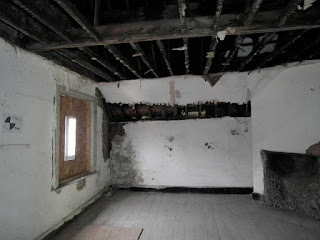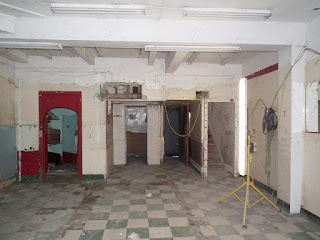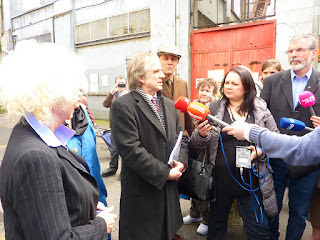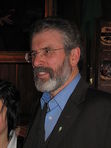Saving Moore Street.
Republicans across the island of Ireland and beyond commemorated the 1916 Easter Rising last weekend. The online Sinn Féin events were all exceptional and I want to commend everyone involved in producing them. The National Commemoration broadcast in particular - including Mary Lou’s oration - was very uplifting.As we continue to commemorate these events, including in a few weeks the executions of the leaders, let’s look at the disgraceful way in which successive Irish governments have refused to preserve Moore Street and its part in the historic events of 1916.So where is Moore Street? Moore Street runs parallel to O’Connell Street- Sackville Street in 1916- from Parnell Street to Henry Street close to the GPO. It is the location of the final meeting of the Provisional Government following the Easter Rising and the final meeting place of five of the seven signatories of the Proclamation. It is also where the O Rahilly - a leader of the Volunteers- was killed. The O Rahilly did not want the Rising to proceed especially after the confusing cancellation order from Eoin MacNeill. However when it went ahead so did he. “I have helped to wind up the clock. I might as well hear it strike” he said.So 104 years ago the battle around the GPO was raging. In other parts of Dublin republican volunteers were holding off significantly larger British Army forces. On Friday evening, and with the GPO in flames, the embattled republican defenders evacuated the building. The O Rahilly was killed leading the first charge. As he lay dying in a shop doorway he penned a last note to his wife. Under constant fire his comrades later made their way to number 5 Moore Street – Dunne’s Butchers, and began tunnelling from house to house along the terrace.The following morning they wrapped Connolly in blankets and with great difficulty carried him through the holes they had forced in the walls to number 16 – Plunkett’s, a poultry shop. It was an agonising journey for Connolly.In a small room Seán MacDiarmada, Pádraig Pearse, Joseph Plunkett, James Connolly and Tom Clarke discussed the limited options open to them, including the possibility of rushing the British Army barricade on Parnell Street. Tom Clarke, who went to look at the situation, returned to tell the leaders that it could not succeed. The leaders came to the reluctant conclusion that surrender was the only choice open to them to avoid further loss of life.Julia Grenan, Winifred Carney and Elizabeth O’Farrell had stayed throughout Easter week in the GPO. O’Farrell was now tasked with the dangerous responsibility of going to the British lines. According to the book ‘Last Words’; “When Seán MacDiarmada asked Nurse O’Farrell to provide a white flag Clarke turned to the wall and broke down, sobbing. Miss Grenan and Miss Carney went across to him to try and consol him but instead they themselves dissolved into tears and Clarke comforted them.”O’Farrell walked down Moore Street to the British barricade. She was brought by British soldiers to Tom Clarke’s shop in Parnell Street where the British General Lowe insisted that he would only accept unconditional surrender. A short time later Pádraig Pearse, accompanied by Elizabeth O’Farrell, and wearing his military overcoat and hat, left the Moore Street headquarters of the Provisional government to meet General Lowe. This meeting occurred on Parnell St opposite Moore St and close to where the Kingfisher Cafe now is. In the original photograph taken of that meeting only Nurse O’Farrell’s feet can be seen and in many of the reproductions they were airbrushed out.After Pearse had signed the document of surrender O’Farrell was asked to deliver the surrender to the outposts which were still fighting. Shortly after 4.30pm the republican garrison left their Moore Street HQ and marched to the Gresham Hotel where they were searched before being taken to the Green in front of the Rotunda Hospital in Parnell Street. There they were harshly treated by their British captors. Éamonn Dore a member of the GPO garrison afterward wrote:“The night at the Rotunda was a bit of a nightmare and water and food did not trouble us. The officer in charge of the British military was a maniac. I saw Frank Henderson kneel to ‘relieve’ himself about day break and the officer snatched a rifle from a Tommy and struck him on the head, knocking in back on the grass ... About five o’clock on the morning of the Sunday, after the office had stuck Henderson, he took Tom Clarke, Seán MacDiarmada, and Ned Daly into the street near the Rotunda Picture House and stripped them down to their boots to search them... Tom Clarke had been wounded at the elbow joint and his arm was in a sling so that he could not get his coat off quickly. The officer pulled the arm straight, opening the wound and tore of his coat.”
 This then is Moore Street. It is at the centre of the battlefield site. “The laneways of history” according to former Taoiseach Enda Kenny.In any other state in the world such places are preserved, open to the public and are a place of pilgrimage. Ron Maxwell, a US filmmaker, describes it well. Quoted by the 1916 Relatives he says: “Battlefields are looking glasses into the world of our ancestors. Standing on their earth under their skies, is to be at one with them and to viscerally understand humanity’s connections across time. The generation that won independence lives in the ideas we honour, the architecture we preserve and the battlefields we can yet save.”But not in Dublin.14-17 Moore Street was adopted by the Irish government in 2007. Thirteen years later no work has begun. The four buildings are in a serious state of disrepair and are closed. The government ignored the recommendations from a consultative group several years ago and successfully appealed a landmark court ruling that Moore Street be preserved. It has pursued a short sighted policy which reduces the battlefield site to these four buildings. The rest are to be demolished as part of a redevelopment plan for the district.Last year the Moore Street Advisory Group submitted its ‘Special Report 2’ to the Minister for Culture. That report drew on the recommendations of the 2017 ‘Securing History – the Moore Street report’ which accepted that “there should be appropriate recognition of the history of the street and its part in the Rising”. Last year’s report called on the government to reconstitute the Moore Street Advisory Group with “representation from the Oireachtas, Dublin City Council, representatives of all of the participating groups on the present group, traders and an independent chair.” A year later and this report still sits on the Ministers shelf.
This then is Moore Street. It is at the centre of the battlefield site. “The laneways of history” according to former Taoiseach Enda Kenny.In any other state in the world such places are preserved, open to the public and are a place of pilgrimage. Ron Maxwell, a US filmmaker, describes it well. Quoted by the 1916 Relatives he says: “Battlefields are looking glasses into the world of our ancestors. Standing on their earth under their skies, is to be at one with them and to viscerally understand humanity’s connections across time. The generation that won independence lives in the ideas we honour, the architecture we preserve and the battlefields we can yet save.”But not in Dublin.14-17 Moore Street was adopted by the Irish government in 2007. Thirteen years later no work has begun. The four buildings are in a serious state of disrepair and are closed. The government ignored the recommendations from a consultative group several years ago and successfully appealed a landmark court ruling that Moore Street be preserved. It has pursued a short sighted policy which reduces the battlefield site to these four buildings. The rest are to be demolished as part of a redevelopment plan for the district.Last year the Moore Street Advisory Group submitted its ‘Special Report 2’ to the Minister for Culture. That report drew on the recommendations of the 2017 ‘Securing History – the Moore Street report’ which accepted that “there should be appropriate recognition of the history of the street and its part in the Rising”. Last year’s report called on the government to reconstitute the Moore Street Advisory Group with “representation from the Oireachtas, Dublin City Council, representatives of all of the participating groups on the present group, traders and an independent chair.” A year later and this report still sits on the Ministers shelf.
 In the meantime we now also know that an archaeology report for Courtney Deery Heritage Consultancy revealed that ‘middens’ or refuse dumps going back several hundred years were found behind 15 and 16 Moore Street. The report concludes that; “The houses and the material assemblage are ordinary and commonplace which through happenstance and historic events has elevated their significance to national importance... “ A second report by Kelly Colgan Architects recommends that nos 10 Moore Street “is of Architectural, Cultural and Social ‘Special Interest’” and should be protected. The same report also identifies numbers 20 and 21 as buildings of “Architectural, Cultural and Social ‘Special Interest.” And finally this report recommends that “O’Brien’s Bottling Stores is of Architectural, Cultural and Social ‘Special Interest” and that it too is protected.Last month there was a fire at number 9 Moore Street which took three fire engines two hours to bring under control. The relatives of the 1916 Leaders are concerned that this will not be the last fire and that without significant and speedy progress there is a real danger to all of these remarkable buildings. Thirteen years after 14-17 Moore Street were designated as a national monument and after years of campaigning the government continues to resist protecting the battlefield site. What the British Army and its shelling of Dublin 104 years ago failed to achieve this government looks likely to succeed in destroying most of what the National Museum has described as “the most important historic site in modern Irish history.”So why does the government refuse to develop this site as a historic quarter which would be of huge educational, economic and social significance to the people of the Inner city, the capital and the nation, as well as a fitting memorial to the heroism of the men and women of 1916?Call me stupid but I don’t think it’s just because the state and the establishment are uncomfortable with the events of 1916 or their refusal to live up to the commitments of the Proclamation. That’s undoubtedly part of it. But it’s also because the vested interests, big business and the developers involved see this battlefield site as a potential source of great wealth for them. It’s all about corporate greed. In many ways the story of Moore Street is a metaphor for the state we are in. If you want to save Moore Street write to An Taoiseach at leo.varadkar @oir.ie or The Dept of An Taoiseach Merrion Street. BAC 2
In the meantime we now also know that an archaeology report for Courtney Deery Heritage Consultancy revealed that ‘middens’ or refuse dumps going back several hundred years were found behind 15 and 16 Moore Street. The report concludes that; “The houses and the material assemblage are ordinary and commonplace which through happenstance and historic events has elevated their significance to national importance... “ A second report by Kelly Colgan Architects recommends that nos 10 Moore Street “is of Architectural, Cultural and Social ‘Special Interest’” and should be protected. The same report also identifies numbers 20 and 21 as buildings of “Architectural, Cultural and Social ‘Special Interest.” And finally this report recommends that “O’Brien’s Bottling Stores is of Architectural, Cultural and Social ‘Special Interest” and that it too is protected.Last month there was a fire at number 9 Moore Street which took three fire engines two hours to bring under control. The relatives of the 1916 Leaders are concerned that this will not be the last fire and that without significant and speedy progress there is a real danger to all of these remarkable buildings. Thirteen years after 14-17 Moore Street were designated as a national monument and after years of campaigning the government continues to resist protecting the battlefield site. What the British Army and its shelling of Dublin 104 years ago failed to achieve this government looks likely to succeed in destroying most of what the National Museum has described as “the most important historic site in modern Irish history.”So why does the government refuse to develop this site as a historic quarter which would be of huge educational, economic and social significance to the people of the Inner city, the capital and the nation, as well as a fitting memorial to the heroism of the men and women of 1916?Call me stupid but I don’t think it’s just because the state and the establishment are uncomfortable with the events of 1916 or their refusal to live up to the commitments of the Proclamation. That’s undoubtedly part of it. But it’s also because the vested interests, big business and the developers involved see this battlefield site as a potential source of great wealth for them. It’s all about corporate greed. In many ways the story of Moore Street is a metaphor for the state we are in. If you want to save Moore Street write to An Taoiseach at leo.varadkar @oir.ie or The Dept of An Taoiseach Merrion Street. BAC 2
 James Connolly Heron and Patrick Coney speaking to the media in Moore Land
James Connolly Heron and Patrick Coney speaking to the media in Moore Land
Published on April 17, 2020 07:50
No comments have been added yet.
Gerry Adams's Blog
- Gerry Adams's profile
- 29 followers
Gerry Adams isn't a Goodreads Author
(yet),
but they
do have a blog,
so here are some recent posts imported from
their feed.



